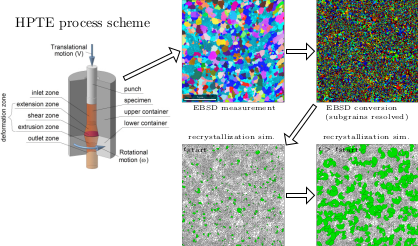Digital twin for microstructural optimization processes due to annealing of SPD treated materials
Severe plastic deformation (SPD) comprises all metal forming methods under an extensive hydrostatic pressure that may be used to impose a very high strain on a bulk solid without the introduction of any significant change in the overall dimensions of the sample [1, 2]. Owing to those large strains, a high defect density and ultrafine-grained microstructures evolve. The high pressure torsion extrusion (HPTE), which was established at the Institute of Nanotechnology (INT), is a SPD technique enabling extreme large shear deformation by simultaneously using rotational and translational motion [3]. The possibility to process long rods and to seamlessly embed the method into technological chains are major advantages of this technique. To pursue target-oriented material design, combined microstructure-micro-mechanics simulations base on the phase-field method [4-6] are elaborated to gain fundamental understanding of the ongoing microstructural mechanisms on mesoscopic length scale and to gather sound knowledge about processing and microstructure property correlations.
A main goal of the optimization of material properties is to create the most favorable combination of strength and ductility, which is often achieved through particular annealing steps subsequent to the SPD process. As a long-term goal we propose to develop a digital twin of microstructure refinement processes of materials treated with SPD methods. To achieve this goal, extensive simulation studies by using phase field method will be carried out to ensure that the model contains all the essential physical processes and influencing variables for the investigation of microstructural processes during SPD deformation and subsequent annealing.
[1] R. Valiev, Y. Estrin, Z. Horita, T. Langdon, M. Zechetbauer, and Y. Zhu. “Producing bulk ultrafine-grained materials by severe plastic deformation”. In: JOM 58 (Apr. 2006), pp. 33–39.
[2] R. Z. Valiev, Y. Estrin, Z. Horita, T. G. Langdon, M. Zehetbauer, and Y.-T. Zhu. “Producing Bulk Ultrafine-Grained Materials by Severe Plastic Deformation: Ten Years Later”. In: JOM 68 (2016), pp. 1216–1226.
[3] Y. Ivanisenko, R. Kulagin, V. Fedorov, A. Mazilkin, T. Scherer, B. Baretzky, and H. Hahn. “High Pressure Torsion Extrusion as a new severe plastic deformation process”. In: Materials Science and Engineering A 664 (2016), pp. 247–256.
[4] A. Vondrous, P. Bienger, S. Schreijäg, M. Selzer, D. Schneider, B. Nestler, D. Helm, and R. Mönig. “Combined crystal plasticity and phase-field method for recrystallization in a process chain of sheet metal production”. In: Computational Mechanics 55.2 (2015), pp. 439–452.
[5] E. Schoof. “Chemomechanische Modellierung der Wärmebehandlung von Stählen mit der Phasenfeldmethode”. German. PhD thesis. Karlsruher Institut für Technologie (KIT), 2020. 229 pp.
[6] C. Herrmann, E. Schoof, D. Schneider, F. Schwab, A. Reiter, M. Selzer, and B. Nestler. “Multiphase-field model of small strain elasto-plasticity according to the mechanical jump conditions”. In: Computational Mechanics (2018). ISSN: 1432-0924.
| Name | Institute |
|---|---|
| Britta Nestler | Institute for Applied Materials - Computational Materials Science (IAM-CMS) |
| Brigitte Baretzky | Institute of Nanotechnology (INT) |
| Julia Ivanisenko | Institute of Nanotechnology (INT) |
| Daniel Schneider | Institute for Applied Materials - Computational Materials Science (IAM-CMS) |


